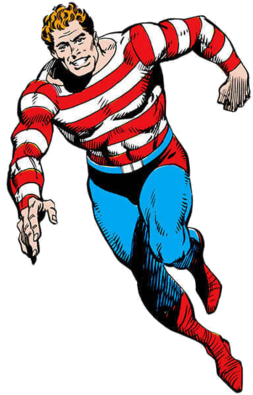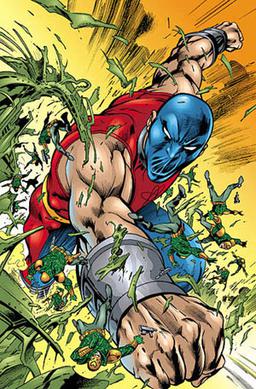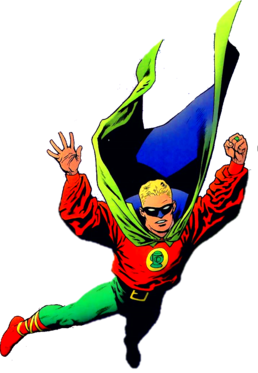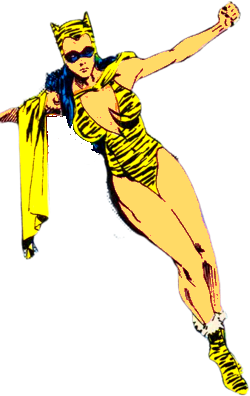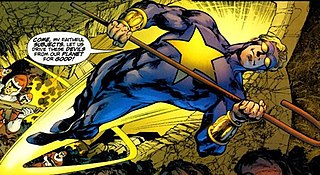| Starman | |
|---|---|
 A collage of various Starmen (clockwise from top): Thom Kallor (background), Mikaal Tomas, Ted Knight, the Starman of 1951, Prince Gavyn, Jack Knight, and Will Payton (center). Art by Tony Harris and Alex Ross. | |
| Publication information | |
| Publisher | DC Comics |
| First appearance | Ted: Adventure Comics #61 (April 1941) Wayne: Detective Comics #247 (September 1957) Star-Man: Detective Comics #286 (December 1960) Tomas: 1st Issue Special #12 (March 1976) Gavyn: Adventure Comics #467 (January 1980) Payton: Starman #1 (October 1988) David: Starman #26 (September 1990) Jack: Zero Hour: Crisis in Time #1 (September 1994) Kallor: Kingdom Come #2 (June 1996) McNider: Starman Secret Files #1 (April 1998) Farris: JLA #23 (October 1998) Old West/Sono: Jonah Hex #27 (March 2008) |
| Created by | Ted: Gardner Fox Jack Burnley Star-Man: Sheldon Moldoff Tomas: Gerry Conway Mike Vosburg Gavyn: Paul Levitz Steve Ditko Payton: Roger Stern Tom Lyle David: Roger Stern Dave Hoover Jack: James Robinson Tony Harris Farris: Grant Morrison Howard Porter Old West/Sono: Jimmy Palmiotti Justin Gray |
| In-story information | |
| Alter ego | Theodore Knight Bruce Wayne (pre-Crisis) Mikaal Tomas Prince Gavyn Will Payton David Knight Jack Knight Thom Kallor Charles McNider Farris Knight Victor Sono |
| Place of origin | Tomas: Talok III Gavyn: Throneworld Kallor: Xanthu |
| Team affiliations | Justice Society of America Justice League |
| Abilities | Star-Man: Super-Strength Tomas: Flight and energy projection derived from the sonic crystal Invulnerability Gavyn: Flight, energy projection & absorption, light/heat and radiation immunity self-sustenance able to withstand exposure to space Payton: Flight, superstrength, superhuman durability, limited shapeshifting, energy projection David: Use of the "Gravity Rod" Farris: Use of the "Quarvat" |
Starman is a name used by several different DC Comics superheroes, most prominently Ted Knight and his sons David and Jack.
Contents
- Theodore Knight
- Starman of 1951
- Star-Man
- Mikaal Tomas
- Prince Gavyn
- Will Payton
- David Knight
- Jack Knight
- Thom Kallor/Danny Blaine
- One Year Later
- Farris Knight
- Victor Sono
- Enemies
- Other versions
- Titles
- Starman (vol. 1)
- Starman (vol. 2)
- In other media
- References
- External links
The original Starman, Ted Knight, was created by writer Gardner Fox and artist Jack Burnley. He first appeared in Adventure Comics #61 (April 1941). [1] Knight is an astronomer who invented a "gravity rod", later reinvented as a "cosmic rod", that allows him to fly and manipulate energy. He donned a red and green costume with a distinctive finned helmet.
Like most Golden Age heroes, Starman fell into obscurity in the 1950s. In the ensuing years, several characters, with varying degrees of relation to the original, briefly took the mantle of Starman.
In Zero Hour: Crisis in Time #1 (September 1994), writer James Robinson and artist Tony Harris introduced Jack Knight, the son of the first Starman. A reluctant non-costumed hero, he inherited his father's name and mission and used his technology to create a cosmic staff. He starred in a critically acclaimed series, written by Robinson, from 1994 until 2001.
The current successor of Starman is Stargirl, formerly the second Star-Spangled Kid.
Starman, announcing that he comes "from the past", appears in Justice League #7 (November 2018) and subsequent issues. [2]
Below, in chronological order of activity (not of appearance), are the characters to have used the name "Starman".





